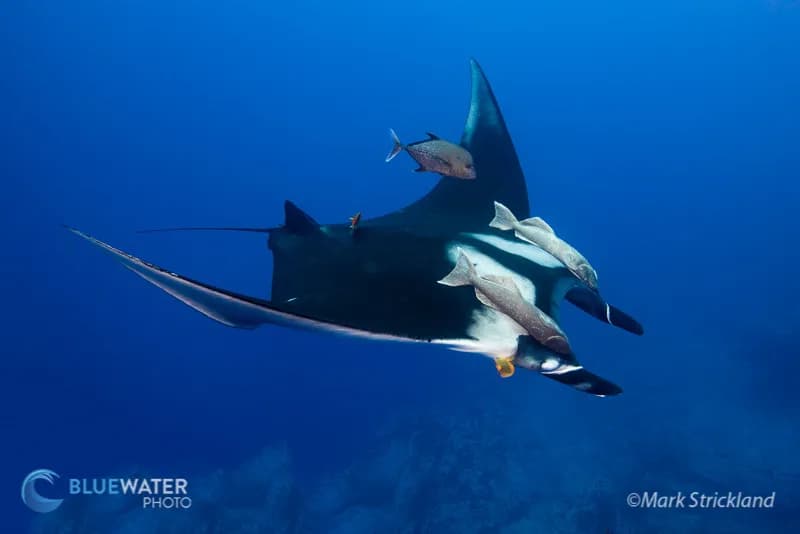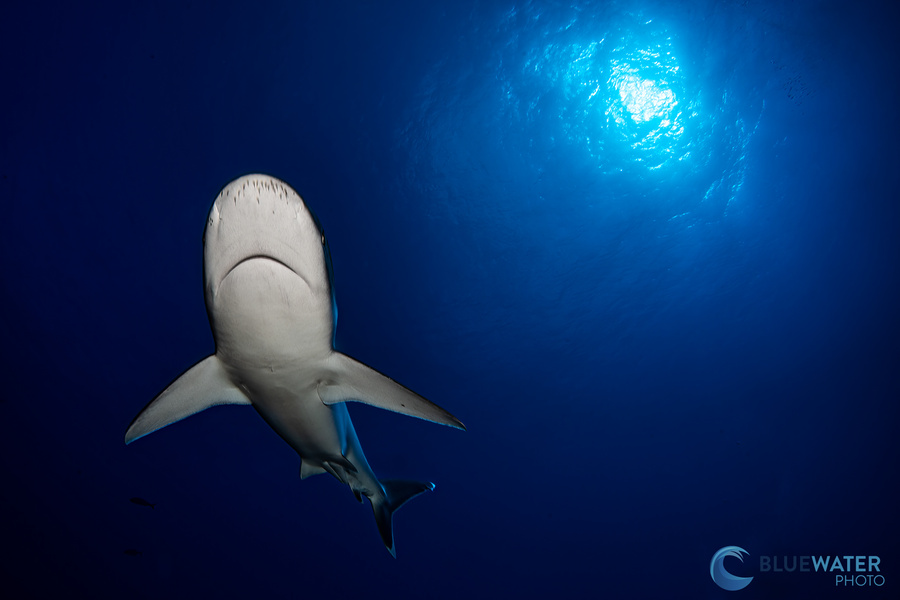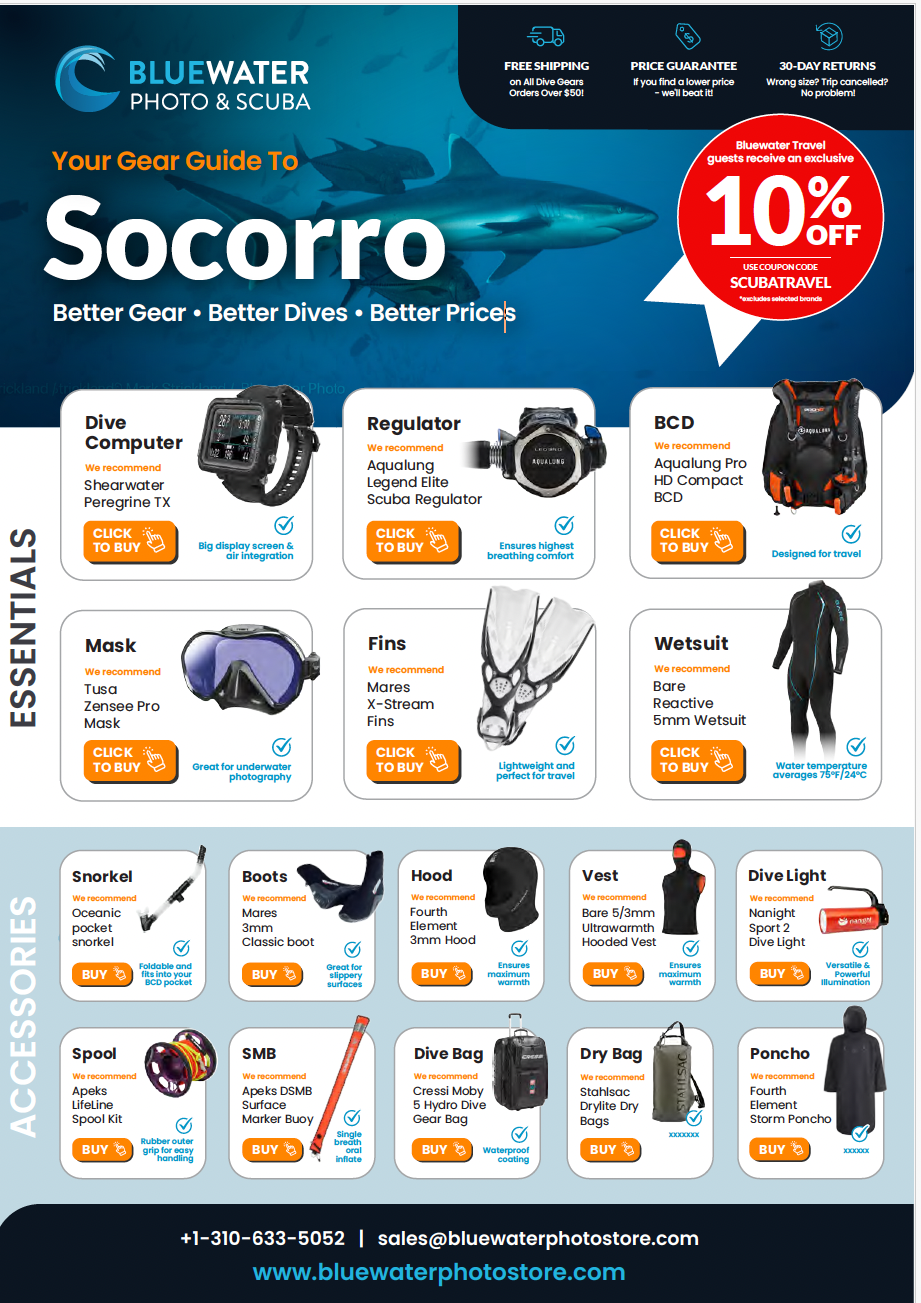We Know Because We Go! | Book with a 5-Star Team,| Trusted by 10,000+ Divers
Best Scuba Diving in Socorro Island
Socorro scuba diving is an underwater adventure filled with exciting encounters with large marine animals, including friendly giant manta rays, playful dolphins, breaching humpback whales, whale sharks, various rays, and over seven shark species!

Socorro Diving Highlights
Socorro scuba diving is an underwater adventure filled with exciting encounters with large marine animals, including friendly giant manta rays, playful dolphins, breaching humpback whales, whale sharks, various rays, and over seven shark species!
Socorro Island is nicknamed Mexico's "Little Galapagos" due to its unique ecosystem that attracts large pelagic animals. The archipelago hosts some of the world's best dive sites for large pelagics, comparable to other Pacific destinations, namely the Galapagos in Ecuador, Cocos Island in Costa Rica,and Malpelo Island in Colombia. Among these amazing scuba diving destinations, Socorro Island is the easiest one to get to from the Americas and most parts of the world.
Note: Marine park fees for Socorro are increasing substantially in January 2025. For more information, read our article, Socorro Marine Park Fee Increase: What You Need to Know.
See our comparison article on diving Socorro, Cocos, and Galapagos.
Interested in diving Socorro? View availability of liveaboards in Socorro and book online at the best price!
Intro To Socorro Island Diving
Socorro Island is a small volcanic island situated 400 km off Mexico's west coast. Diving Socorro is renowned for encounters with the world's friendliest manta rays and other large marine animals like sharks, dolphins, tuna and whale sharks.
Socorro Island is one of the four main islands that form the Revillagigedo Archipelago in Mexico. Socorro Island, Roca Partida, San Benedicto, and Clarin make up the Revillagigedo UNESCO World Heritage Site and are all amazing spots for scuba diving. These four islands combined are commonly referred to the Socorro Islands or simply "Socorro".
Socorro scuba diving is easily accessible to those who live in the United States. Divers fly into San Jose Del Cabo (SJD), which is the departure point for most liveaboards.
More on How to Get to Socorro or View Socorro's Location on Google Maps
See this amazing video of diving the Socorro Islands:
Socorro Liveaboards
The only way to scuba dive in Socorro is via liveaboard, and there are plenty of options ranging from budget to luxury. Most Socorro trips last 8 nights and the crossing from Cabo to Socorro typically takes about 24 hours. Check out the liveaboards of our Preferred Partners - Nautilus' fleet of vessels: Belle Amie, Explorer, and Under Sea; theSolmar V; the Quino El Guardian, and Rocio Del Mar.
Schedule a free consultation with a travel expert now
Booking with us is free
Trusted by 10,000+ Divers worldwide
Best Time To Go Scuba Diving In Socorro
The scuba diving season in the Socorro Islands runs from November to May, and the liveaboard itineraries correspond.
The best time to dive Socorro depends on what you want to see and what conditions you are comfortable with. Manta rays and various sharks are present year-round. Humpback whales congregate around the archipelago in February and March, although divers have to be lucky to see them underwater.
Bluewater Travel hosts an annual trip to Socorro in March - a time when marine life is abundant and there is a chance to see or swim with humpback whales.
November and December are the warmest months to dive Socorro, with temperatures reaching 27C/80F.This is also whale shark season, so if diving with whale sharks is on your bucket list, these are the best months to visit Socorro.
Water temperatures start to warm up again in late April and into May, which marks baitball season when you can witness many predators hunting, including sharks and tuna.
Join our next trips to Socorro in February 2026, and February 2027!


Difficulty level
We recommend Socorro for experienced divers due to the exposed nature of the diving and challenging conditions. The islands often experience rough seas and strong currents, which attract the rich pelagic life. The dive sites are rugged, with rocky structures and some huge walls.
For a location suitable for all experience levels, read our guide to diving in Cozumel, Mexico here.
Socorro Diving Information
Marine Life & Photography Subjects
The Revillagigedo Archipelago is home to a bounty of sought-after marine animals, so pack your wide-angle lens or action camera and get ready to capture the unforgettable encounters. Expect manta rays, sharks, whales, dolphins, tuna, whale sharks, and plenty of other fish during your dives in Socorro.
Manta Rays
Experience diving with friendly majestic manta rays year-round in Socorro, a destination well-known for its manta cleaning stations. Observe these gentle giants and capture incredible underwater images and videos as the mantas glide around the cleaning station and play in divers' bubbles.




If you're not careful swimming with manta rays in Socorro could turn into an addiction that's hard to break. They're incredibly friendly! Photos by Scott Gietler & Nirupam Nigam.
There aren't many places in the world that can match the manta ray experience in Socorro. The giant manta rays in Socorro seem to seek divers out as they swim directly overhead and enjoy the bubbles hitting their unique bellies. Having visited so many places in the world, our team of travel advisors agree that swimming with manta rays at Socorro Island is something that should be on everyone's scuba diving bucket list.
For another awesome manta ray destination, check out our Maldives liveaboards.
Various Sharks
Shark lovers, rejoice! Galapagos, silky, silvertip, whitetip, and hammerhead sharks are common in Socorro, enabling you to check off multiple bucket list species on one dive trip.It is even possible to spot tiger sharks with some luck. The shark dives in Socorro Island are simply world-class, placing this destination high on our list of best locations for shark diving.


Hundreds of silky sharks enveloping divers in an epic feeding frenzy. Photographed during a Bluewater trip in March 2018.




Whitetip reef sharks sleep (top) and a school of hammerhead sharks (bottom). Photographed during Bluewater's 2023 Socorro trip.
Whales, Dolphins, and More
Another "signature experience" at Socorro Island is swimming with a group of bottlenose dolphins that often visit divers and typically make several close passes. Experiencing intimate encounters with dolphins in their natural habitat is remarkable, as these curious mammals often seem to put on a show of their own for divers.


Seeing a pod of dolphins during a dive is not uncommon.
Whale sharks are most frequently spotted in November and December, and schools of pelagic fish like jacks and barracuda regularly cruise the waters around Socorro. Divers often see large gamefish like tuna, wahoo, and marlin - something few other destinations can offer.




A whaleshark (L) and a tuna (R). Photos by Tim Yeo.
When the water cools in February and March, divers are often treated to humpback whale sightings. Lucky visitors can see the whales spouting and breaching the surface of the rugged sea from the liveaboard, and if you're really lucky, you can even swim with them or spot them underwater during a dive.




Photos by Christina Ricafort (L) & Nirupam Nigam (R)
Macro Photography in Socorro
While it's not really the best place to go for macro photography, divers who insist on bringing along their macro lens can find eels, octopuses, nudibranchs, and a variety of other critters. Macro photography is rarely the highlight of a Socorro dive trip, so it is best to ask in advance if macro photography opportunities will be present during your Socorro liveaboard trip.
Socorro Diving Conditions
- Water Temperature: Ranges from 24-27C/75-80F in November, December, beginning of January, late April, and May. Expect cooler temperatures between 21-23C/70-74 F in late January, February, March, and the beginning of April.Many divers use a 5mm wetsuit with an optional hooded vest, but it depends how cold you feel underwater. Note that dive gloves are not permitted at Socorro by law.
- Depth Range: 33 - 100ft (10 - 30m)
- Visibility: Varies depending on the dive site, season, currents, and other conditions. Roca Partida often has the best visibility, reaching over 100 feet. There are sometimes reports of lower visibility in November/December (when whale sharks are found feeding on plankton).
Typical Socorro Dive
A typical dive in Socorro is conducted from pangas, small boats that offer easy access to dive sites. Divers do a backroll entry into the water and descend to approximately 60-80 feet (18-25 meters) or to the appropriate depth to find mantas and sharks. After exploring the depths and encountering these magnificent creatures, divers begin their ascent in a multi-level dive profile. Safety stops are typically carried out in the blue water, allowing for an additional chance to spot pelagic life.
Liveaboards typically offer three to four dives daily at the best sites around Socorro, Roca Partida, and San Benedicto Islands. Clarion is further away and usually not visited on a week-long trip.
To learn more about diving in Socorro, read about our 2022 Socorro group trip.
Best Dive Sites In Socorro
Here are some of the best dive sites in Socorro:
- Roca Partida
- The Boiler, San Benedicto Island
- The Canyon, San Benedicto Island
- Cabo Pearce, Socorro Island
- Punta Tosca, Socorro Island
- The Aquarium
- Roca Partida: Like Wolf and Darwin Islands in the Galapagos, it ranks as one of the best dive sites in the world for big animal encounters. This is where the iconic photos of stacked whitetip reef sharks can be found. All kinds of marine life are attracted to the isolated pinnacle, like Galapagos sharks, massive schools of jacks and bonito getting hunted by dolphins and tuna, humpback whales and whale sharks in season, and, of course, many giant rays.
- The Boiler, San Benedicto Island: A large pinnacle rises to about 20 feet from the surface, so you can't see it from topside. The surf and swell running across the top sometimes make the water look like it's boiling. The pinnacle is small enough to swim around during one dive, and it looks very majestic from all angles. The bottom is at around 160', so getting your weights right and not being too heavy is very important. This area is a popular cleaning station for the giant Pacific manta. They gather here to be cleaned by the Clarion Angelfish. It is usually just a matter of a few minutes in the water before the mantas start to show up. As they approach, they look you right in the eye, and you feel like you are communicating with them. In one dive at The Boiler, we were fortunate enough to see a humpback whale underwater, followed by a sighting of a tiger shark.
- The Canyon, San Benedicto Island: This is a great dive site for shark lovers. There are two cleaning stations where divers often see silvertip sharks and Galapagos sharks. Hammerheads also often frequent this dive site, along with the occasional tiger shark.
- Cabo Pearce, Socorro Island: Cabo Pearce has one of the best manta cleaning stations in the world. Expect to see mantas flying in to get cleaned. Hammerhead sharks are often found out in the blue, and silky sharks follow divers to their safety stops.
- Punta Tosca, Socorro Island: Punta Tosca is another site on Socorro Island. There are often playful, sociable dolphins here, and sometimes Silky sharks.
- The Aquarium: The afternoon dives were done on the other side of the island at a spot called "The Aquarium". We could see whales just offshore the entire time we were there and we enjoyed a beautiful sunset.
Socorro Travel Information
How To Get To Socorro
The only way to get to and dive Socorro is on a Liveaboard due to the remoteness of the island. There are no day boat trips so you're only option is booking a liveaboard trip.
Divers fly into Los Cabos International Airport (SJD). Once through immigration, you'll make your way to your liveaboard's departure point at either San Jose Del Cabo (15 mins) or Cabo San Lucas (40 mins). Most boats take about 24 hours to reach Socorro from either city.
Other Things To Do
Baja California has so much to offer divers and non-divers alike, so plan extra days to explore the wealth of things to do. Don't miss the unique opportunity to watch, pet, and kiss gray whales in San Ignacio. Enjoy scuba diving in La Paz, Cabo Pulmo, and Cabo San Lucas. Snorkel with whale sharks and sea lions in La Paz, embark on marine life safaris in Cabo San Lucas, and explore topside with adventure sports like hiking, horseriding, and ATV-ing. If you want some rest and relaxation, there are lots of exclusive luxury resorts in Cabo San Lucas.
Find out more about diving Cabo San Lucas.
Practical Information
- Currency: Mexican Peso
- Language: Spanish is the official language in Mexico, but most people today learn English as a second language
- Time Zone: UTC-7
- Electricity: 127 V 60 Hz
Useful Tips For Cabo San Lucas
Socorro liveaboard trips typically leave from Cabo San Lucas. Here are some useful tips that you can use before and after your trip!
- "Los Cabos" refers to Cabo San Lucas and San Jose del Cabo. Cabo means "Cape" in Spanish. San Jose and San Lucas are how the "locals" refer to the two areas Both San Jose and San Lucas are beautiful towns located right on the ocean. Cabo San Lucas is a larger town and more developed than San Jose del Cabo. Both offer numerous resorts right on the water with amazing ocean views.
- Ubers are not allowed to pick passengers up at the airport (SJD), but there are several private and shared shuttle options that can be pre-booked or booked upon arrival. Ask one of our travel agents for shuttle service recommendations.
- The Mexican Peso is the local currency accepted everywhere in Cabo, but many restaurants and souvenir shops in the tourist areas also accept US Dollars.
- Mexican Customs may charge a tax for any professional-grade camera equipment, including drones. Visit our article to learn more about the Mexico Camera Tax and what to expect.
- March is spring break month, so be sure to book flights and hotels early!
Recommended Scuba Gear
Download our full scuba gear guide to Socorro, Bluewater Travel guests receive 10% OFF! Click the image below to download (PDF).


Schedule a free consultation with a travel expert now
Booking with us is free
Trusted by 10,000+ Divers worldwide